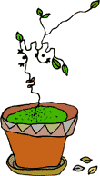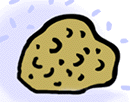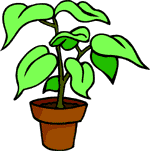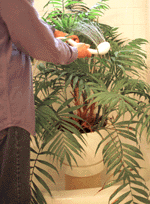
Add years to your houseplants
With these simple cleaning tips
By Marion Owen, Fearless Weeder
for PlanTea, Inc. and
Co-author of Chicken Soup for the Gardener's Soul
FEATURE ARTICLE:

Tom Hanks' "Power of Four" solution
More good stuff:
Who is Marion Owen?
FAQs about PlanTea
Search Marion's articles, tips and recipes
Why grow organic?
News and press releases
Read love letters
How to link to this site
Need a speaker?
How to contact Marion
Visiting Alaska?
Come to Kodiak Island!
Go to home page

Marion's UpBeet Gardener
Newsletter has been
replaced by Marion's blog
which you can find at:
www.marionowen.wordpress.com

Erma Bombeck once said, "Never go to a doctor whose houseplants have died."
Erma's columns were entertaining, and her wisdom went beyond words. But what she's really asking is, "Why would you want to see a doctor who couldn't even keep a simple office plant alive?"

I'm sure the good doctor never intended to kill the plants. They probably perished from neglect. What he didn't realize, is that a little preventive maintenance goes a long-g-g way for humans as well as plants.
Take cleaning, for example.
You wouldn't want to go months without taking a shower, would you?
Neither do your house plants. (Or is it houseplants?)
Why dirty houseplants lead a tough life
 Plants
growing outdoors are washed regularly by rain and feather dusted by the
wind. But it's up to us to clean indoor plants, especially the hard-working
ones--houseplants that clean air. Dust, grease, oil, and other airborne
particles settle on leaves, making them unattractive and dull-looking.
Leaves that are dirty can't absorb as much sunlight as clean ones.
Plants
growing outdoors are washed regularly by rain and feather dusted by the
wind. But it's up to us to clean indoor plants, especially the hard-working
ones--houseplants that clean air. Dust, grease, oil, and other airborne
particles settle on leaves, making them unattractive and dull-looking.
Leaves that are dirty can't absorb as much sunlight as clean ones.
This affects overall plant health because plants sustain themselves through photosynthesis, a process in which the leaves absorb sunlight and carbon dioxide to make their food. When plants are coated with residues, their stomata (stoh-MAH-tuh), the openings through which they exhale oxygen and inhale carbon dioxide, become blocked and they have a difficult time with this critical process.
Imagine trying to eat a sandwich through a strainer. . .
|
"Like
people, plants respond to extra attention." |
Peridically cleaning your houseplants improve their appearance (we all like to look our best, right?), stimulates growth, and helps to control insects and other pests. One more thing. No plant likes to be left in the corner and fogotten. They thrive when you putz around and and pay more attention to them. Try it! (To learn more about caring for houseplants, check out my articles, Houseplants That Clean the Air and Aquarium Water and Coffee Grounds: Unusual and Healthy Houseplant Foods That Are Right Under Your Nose.)
|
Tired
of bugs bugging you? |
How to turn your houseplants into bathing beauties
Clean your indoor house plants every couple months or so. If you live in a dusty area, do it more often. Clean firm, not African violets and other hairy-leafed plants, with a soft sponge or cloth. A word about sponges here. Look for soft, pliable, and gentle ones. Avoid coarse, rough sponges like loofas and some commercial varieties--even if you have to test squeeze them in the store! The best sponges are natural cellulose types and the big, light brown, round-cornered ones (not loofas) that are used at car washes. Baby sponges also work great. You know the kind I'm talking about.

Houseplants prefer soft sponges
For cloths, put away the paper towel and wash cloth. Find an old, but clean, white T-shirt. Tear or cut it into four sections.

Moisten the sponge or T-shirt with plain, tepid water. Don't use milk (a recent fad and bad idea), vegetable oil, or those commercial "leaf shine" products. They only clog the leaf pores. For extra-dirty plants, go ahead and add a couple drops of liquid, non-detergent soap, such as Ivory.
Support the leaf on an upturned hand and gently wipe with the other. Try to clean the top and bottom of each leaf. For plants with hairy leaves, such as African violets, do not clean them with a damp sponge or cloth. Use a soft cosmetic or children's brush; even a feather duster.
Re-creating the tropics

Most houseplants call the tropics "home."
The majority of houseplants orginate from the tropics, so it's not wonder that they love to be misted. Most interior spaces however, have very low humidity, which explains why most houseplants dry out so quickly. Brown leaf tips are one of your first clues.
Think of misting as a form of preventive maintenance. It helps discourage dust from settling and sticking to the leaves in the first place and it keeps the leaves from drying out. Remember to use tepid, not cold tap water!
Houseplants like to go outside and play
 If
the weather is warm enough and it's not too windy, take your plant outside
for a "walk." (Mark your calendars: July 27 is "Take Your Plant for a
Walk" Day). Mist it well with a spray bottle. The excess water can drip
all it wants without harming floors or carpets.
If
the weather is warm enough and it's not too windy, take your plant outside
for a "walk." (Mark your calendars: July 27 is "Take Your Plant for a
Walk" Day). Mist it well with a spray bottle. The excess water can drip
all it wants without harming floors or carpets.
A watering can will also do the trick, but avoid the garden hose as the water may be too cold. This is a also good time to inspect your plants for pests like spider mites. thrips, fungus gnats, aphids, and scale.
If you come across some brown leaves, it's alright to snip off the brown parts. When the tips and edges of plant leaves are shriveled and brown, it usually indicates that the plant is drying out and the period between waterings is too long. Do I sense heads nodding at this point?
It's shower time!
Sponging and misting help a lot, but there comes a point when more is better. If outdoor conditions won't allow a misting, head for the bathroom shower. Showers give plants a top notch cleaning, much like going to the car wash is more effective than spraying your car with a hose.
Potting soil also gets a good cleansing. When you water plants with little sips, water doesn't get down to the roots. Thorough waterings help encourages plants to "reach for it," thus better, deeper root growth. Thorough soakings also flush out toxic salts deposited from chemical fertilizers and residues left from tap water. These deposits leave a white, chalky deposit on the surface of the soil and plant pots.
And, you'll be happy to know that pests such as aphids and spider mites can't swim.
How to give your plants a shower
- Put away the shampoo.
- Turn on the water. Adjust the pressure to a gentle spray, and the
temperature to "baby bottle" lukewarm.

Cleaning your houseplant in the shower.
Setting the plant on a support makes cleaning easier.
- Set your plant inside the shower, preferably on a plastic stool, milk crate or overturned bucket. It makes things easier when it comes to Step 6.
- Close shower door or curtain.
- Move water stream up and down, back and forth around leading edge of plant. (A Shower Massage works great here).
- Rotate plant 90 degrees and repeat Step 5 until the whole plant has been washed. This will take a few minutes. Be prepared to get wet, too.
- Turn off water and let the plant hang out in the moisture for an hour or so. Believe me, to a plant, this is a real treat.
Before moving a container with an attached bottom tray, tip it slightly to dump out any excess water that has collected in the tray. One time after giving my weeping fig its first shower, I picked it up and headed toward the living room. Before taking two steps, my whole front was baptized with plant water.
Speaking of moving plants, when you go to move them out of the shower, be very careful. "A pint's a pound the world around" which means water is heavy stuff. And super-saturated soil can be quite heavy. Slide the container onto a towel or bathrobe to make it easier (on your back) to move.
Plants that DO and DON'T like showers
Plants that like, er, benefit from a shower include ficus, palms, ivy, citrus, coffee, ferns, and spider plants, to name a few. Plants that don't like getting too wet include cacti and other succulents, and those hairy-leaved types I talked about earlier. Water tends to cause spots and other discolorations.
Next time your houseplants are looking a little dull, give them a sponge bath. Don't forget the rubber ducky!

Thanks for visiting and please stop by again. I'll put the coffee on!
Meet Marion Owen /// Learn about PlanTea /// Online Catalog /// Articles, Tips, Recipes /// Get free UpBeet Gardener newsletter /// Read current issue /// Listen to radio show /// Read news and press releases /// More resources and links /// Learn why 'grow organic?' /// View guidelines for retailers /// Read love letters /// Book Marion as a speaker /// Site map /// How to link to us /// Contact us /// Go to home page
PlanTea: The organic plant food in tea bags. http://www.plantea.com
Copyright ©1996 to present: PlanTea, Inc. All Rights Reserved. PO Box 1980, Kodiak, AK 99615-1980 USA
Questions or comments? marion@plantea.com Phone: Toll Free: 1-800-253-6331 (US and Canada); 907-486-2500